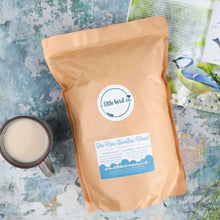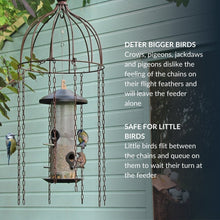Birdwatching With Your Eyes Closed - Learning to Recognise Bird Song

Imagine stepping out into your garden at dawn. The world is still and grey, but then you hear a blackbird’s song, bold and melodic. Without even looking, you know which bird has begun its day. That’s the magic of birding by ear. While we often think of birdwatching as a visual passtime (think binocular- wielding and welly-wearing), when we listen as well as look, we can add a new dimension. You can “see” birds that remain out of sight, hidden in thick trees or too distant to spot with binoculars, and you can learn to enjoy the birds last thing at night and first thing in the morning when visibility is poor.
Recognising birds by their songs not only helps you identify more species, but it also connects you to nature in a more mindful way. You become attuned to the behaviour of your garden birds, and their interactions, throughout the changing seasons—all via their songs and calls. I know when I learned to recognise the resident robin in our garden by his song, I felt happy every time I went out in the garden and heard him - even though I couldn’t always see him, I knew he was there. And using my bird song app on walks has been brilliant - there are birds I definitely never get visiting our garden that are just branches away when I’m in the woods. I don’t always have time to stand and watch the trees, but knowing I’ve made that little connection all the same makes me happy.
Why do Birds Sing?
Not all birds sing - some only call to communicate simple messages. But for a lot of our British songbirds, singing is serious business. When a robin serenades you from its perch, it’s actually staking a claim to its territory, warning other males to stay away while also signalling to potential mates that he’s ready and available. The songs we hear are the product of evolution, developed over thousands of years to serve a dual purpose: showing off a bird’s fitness and strength, and making sure his neighbours know not to mess around. But it’s not just about romance and rivalry. Singing can also be a way to bond within a flock or to coordinate activities like feeding or migration. Some species, like the starling, have complex songs that can incorporate mimicry of other birds and even human-made sounds, which shows their intelligence and adaptability.
How do Birds Sing?
Birds produce sound using a vocal organ called the syrinx. Unlike the human larynx, the syrinx has two sets of vocal cords, allowing some birds to produce two different notes simultaneously. We use the shape of our mouths and our toungues to adjust the sound that comes from our mouths, but a bird alters the tension in the membranes of their syrinx to modulate the pitch, tone, and volume of their song. Birds generally learn their songs by listening to others, particularly older males. Young birds pick up the tunes from their parents or neighbours, but there’s also an instinctual element—they’re born with a rough idea of how their species should sound, and then practice makes perfect. Different species of birds don’t typically understand one another’s songs in detail, but they can recognise general signals like alarms or threats. The size of a bird affects the sound it produces—larger birds tend to have deeper, richer songs, while smaller birds often sing higher- pitched, faster tunes.
More Than Melody
While songs are what many people associate with birds, calls are an equally important part of their repertoire. Birds use calls to communicate urgent messages, and these vocalisations are typically shorter and more urgent-sounding. A robin’s piercing “tick-tick-tick” alarm call warns nearby birds of predators. In contrast, the soft “seep” of a passing flock of goldfinches keeps the group together while they’re flying. Begging calls are used by chicks to demand food from their busy parents, and sparrows use a variety of calls to share their location when they’re moving through the hedgerows. Learning to differentiate between a bird’s song and its calls opens up a new layer of understanding. The songs and calls birds make are tied to their habitats and their lifestyles. The skylark lives in open countryside, and has a complex, soaring song that travels across fields and moors. The wren lives in woodland and has a high-pitched, complicated song that carries through dense vegetation. Some birds use mimicry as part of their repertoire, which can help them stand out during courtship, impressing potential mates. By imitating a wide range of sounds, from other bird species to human-made noises like car alarms or phone ringtones, these birds showcase their intelligence and adaptability. In some cases, mimicry may also help birds blend into their environment, confuse predators, or establish dominance over a territory by mimicking rival species.
Your Favourite Tunes
Some bird songs stick with you, and over time, favourites emerge. For me, the blackbird’s song always makes me smile—it’s bold full of personality, and his abrupt “tuk-tuk-tuk” alarm cry always has me with my sleeves rolled up, ready to protect him from whatever it is that has him spooked. At five foot one, I always empathise with the wren, who is so loud, despite its tiny size. Its rapid- fire, explosive trill is incredibly complex melodically - you can find it slowed down online to appreciate it more.
Seasonal Birdwatching
Birdsong is a year-round activity, though different birds sing at different times of the year. Spring is famously the peak of bird song, with males singing to attract mates and establish territories, and the dawn chorus in April and May is a must- hear for any bird lover. As summer arrives, the birds quieten down, shifting their focus to raising their young. By autumn and winter, you’ll mostly hear calls rather than songs. Only a few birds sing all year round, and in the book Birdwatching With Your Eyes Closed, Simon Barnes suggests that these quieter months are the perfect time to start learning birdsong. The feisty robin, for instance, defends his territory with his melodic tune even in the colder seasons, making him an ideal bird to listen for in autumn and winter. As you gradually tune into other birds one by one, you’ll build a foundation of birdsong knowledge, and by summer, you’ll likely know the songs of most of the birds in your garden. If you get stuck, an app is a great way to identify a new bird - I love using the Merlin app.
Birdwatching is a great way to connect with nature, offering a peaceful escape from the busy-ness of life. But when you tune into birdsong, the experience becomes even richer. I hope you connect with your garden birds through their song this month, and that you enjoy “birdwatching with your eyes closed” as much as I do!
Ready to deepen your connection with the birds in your garden? Discover more about your feathered friends and how to attract them to your space with Amidst the Birdsong: A Garden Birdwatcher's Journal. This beautifully crafted journal is the perfect companion for anyone looking to observe and learn about the birds visiting their garden. Start your birdwatching journey today – click here to learn more.


















